The topic of this article may not meet Wikipedia's general notability guideline .(April 2015) |
The Seven Natural Wonders of Africa was a competition where the seven were selected by voting on February 11, 2013. [1] [2]
The topic of this article may not meet Wikipedia's general notability guideline .(April 2015) |
The Seven Natural Wonders of Africa was a competition where the seven were selected by voting on February 11, 2013. [1] [2]
| Image | Nominee | Location |
|---|---|---|
 | Red Sea Reef | Coast of Egypt, Eritrea, and Sudan |
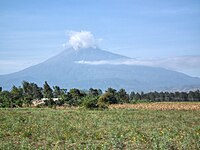 | Mount Kilimanjaro | Tanzania |
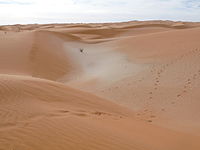 | Sahara Desert | Algeria, Chad, Egypt, Libya, Mali, Mauritania, Morocco, Niger, Sudan, Tunisia, Western Sahara |
 | Serengeti Migration | Tanzania and Kenya |
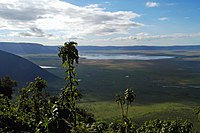 | Ngorongoro Crater | Tanzania |
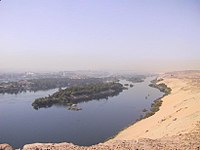 | Nile river | Ethiopia, Sudan, Egypt, Uganda, Democratic Republic of the Congo, Kenya, Tanzania, Rwanda, Burundi, South Sudan, Eritrea |
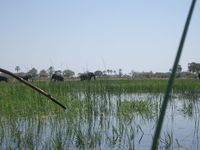 | Okavango Delta | Botswana |
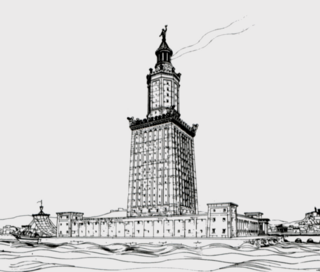
The Lighthouse of Alexandria, sometimes called the Pharos of Alexandria, was a lighthouse built by the Ptolemaic Kingdom of Ancient Egypt, during the reign of Ptolemy II Philadelphus. It has been estimated to have been at least 100 metres (330 ft) in overall height. One of the Seven Wonders of the Ancient World, for many centuries it was one of the tallest man-made structures in the world.

The Colossus of Rhodes was a statue of the Greek sun god Helios, erected in the city of Rhodes, on the Greek island of the same name, by Chares of Lindos in 280 BC. One of the Seven Wonders of the Ancient World, it was constructed to celebrate the successful defence of Rhodes city against an attack by Demetrius I of Macedon, who had besieged it for a year with a large army and navy.
Eighth Wonder of the World is an unofficial title sometimes given to new buildings, structures, projects, designs or even people that are deemed to be comparable to the seven Wonders of the World.
The Seven Wonders of Wales is a traditional list of notable landmarks in north Wales, commemorated in an anonymously written rhyme:

Ngorongoro Conservation Area is a protected area and a UNESCO World Heritage Site located in Ngorongoro District, 180 km (110 mi) west of Arusha City in Arusha Region, within the Crater Highlands geological area of northeastern Tanzania. The area is named after Ngorongoro Crater, a large volcanic caldera within the area. The Ngorongoro Conservation Area Authority administers the conservation area, an arm of the Tanzanian government, and its boundaries follow the boundary of the Ngorongoro District in Arusha Region. The western portion of the park abuts the Serengeti National Park, and the area comprising the two parks and Kenya's Maasai Mara game reserve is home to Great Migration, a massive annual migration of millions of wildebeest, zebras, gazelles, and other animals. The conservation area also contains Olduvai Gorge, one of the most important paleoanthropological sites in the world.

Seven Wonders of the Industrial World is a 7-part British docudrama television miniseries that originally aired from 4 September 2003 to 16 October 2003 on BBC and was later released on DVD. The programme examines seven engineering feats that occurred since the Industrial Revolution. The same feats are covered in a companion book of the same name by producer Deborah Cadbury.
Seven Natural Wonders is a television series that was broadcast on BBC Two from 3 May to 20 June 2005. The programme takes an area of England each week and, from votes by the people living in that area, shows the 'seven natural wonders' of that area in a programme.
Wonders of the World are lists compiled over the ages that catalogue remarkable natural and man-made constructions.
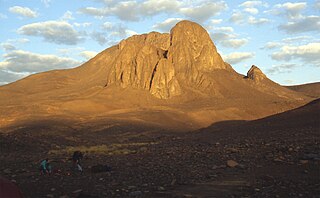
Mount Tahat is the highest mountain in Algeria. It sits at an elevation of 2,908 metres. Other sources indicate an elevation of 3,003 metres (9,852 ft). Tahat is also the highest peak in the Hoggar Mountains. Its nearest city is Tamanrasset which is located 56 kilometres (35 mi) to the south.

The New 7 Wonders of the World was a campaign started in 2001 to choose Wonders of the World from a selection of 200 existing monuments. The popularity poll via free Web-based voting and small amounts of telephone voting was led by Canadian-Swiss Bernard Weber and organized by the New 7 Wonders Foundation (N7W) based in Zurich, Switzerland, with winners announced on 7 July 2007 in Lisbon, at Estádio da Luz. The poll was considered unscientific partly because it was possible for people to cast multiple votes. According to John Zogby, founder and current President/CEO of the Utica, New York–based polling organization Zogby International, New 7 Wonders Foundation drove "the largest poll on record".
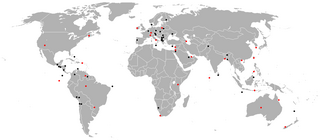
New 7 Wonders of Nature (2007–2011) was an initiative started in 2007 to create a list of seven natural wonders chosen by people through a global poll. It was the second in a series of Internet-based polls led by Swiss-born Canadian Bernard Weber and organized by the New 7 Wonders Foundation, a Swiss-based foundation which Weber founded. The initiative followed an earlier New 7 Wonders of the World campaign, and attracted 100 million votes from around the world before voting finished on November 11, 2011.

The Seven Wonders of Ukraine are seven historical and cultural monuments of Ukraine, which were chosen in the Seven Wonders of Ukraine contest held in July, 2007. This was the first public contest of that kind which was followed by the Seven Natural Wonders of Ukraine, the Seven Wonderful Routes of Ukraine, and the Seven Wonderful Castles of Ukraine. All nominated sites are publicly owned protected areas of at least regional level, available for tourism.

Zimbabwe boasts several tourist attractions, located in almost every region of the country. Before the economic changes, much of the tourism for these locations came to the Zimbabwean side but now Zambia benefits from the tourism. The Victoria Falls National Park is also a tourist attraction and is one of the eight main National Parks in Zimbabwe, largest of which is Hwange National Park. Zimbabwe is home to one of the Seven Natural Wonders of the World, the Victoria Falls.

Various lists of the Wonders of the World have been compiled from antiquity to the present day, in order to catalogue the world's most spectacular natural features and human-built structures.

The Seven Wonders of the Ancient World, also known as the Seven Wonders of the World or simply the Seven Wonders, is a list of seven notable structures present during classical antiquity. The first known list of seven wonders dates back to the 2nd–
Seven Natural Wonders is an organization that was created with the mission of protecting and promoting the natural wonders of the world. The project was launched in 2008 in response to the New 7 Wonders efforts to change the natural wonders of the world. This announcement was made following the campaign's efforts to establish a new list of modern man-made wonders.
The Seven Natural Wonders of Romania are the seven natural wonders of Romania, which were chosen in the Seven Natural Wonders of Romania contest held in July, 2008. It was the second stage of the Seven Wonders of Romania program started in 2007. The voting consisted of two parts: experts in Romania voted for their seven best sites, and internet users voted for their seven favorite sites on the official website.
The Seven Wonders of Russia as determined by a project organized by the newspaper Izvestia, Radio Mayak, and the television channel Russia. The competition took place in three stages from 1 October 2007 through 1 June 2008, with the final results declared in Moscow's Red Square on 12 June 2008.

Seven Wonders of the World is a 1956 documentary film in Cinerama. Lowell Thomas searches the world for natural and man-made wonders and invites the audience to try to update the ancient Greek list of the "Wonders of the World".
The Seven Natural Wonders of the UK is a list compiled in May 2021 by the Royal Geographical Society. The seven wonders were chosen for their "shared beauty, uniqueness, and geological significance". There are four wonders in England, one in Northern Ireland, one in Scotland and one in Wales.